Did you know Potatoes make the most popular tubers plants to grow in the backyard?
In fact, many gardeners create raised-garden beds to sow Potatoes, but it would not be enough to deter pests that plague most Potato yields.
Therefore, growing Potato companion plants will help keep pests away and improve their growth and taste.
The best Potato companion plants include herbs like Basil, Tansy, and Cilantro; flowers like Marigolds, Alyssum, and Nasturtiums; and veggies like Legumes, Horseradish, and Corn.
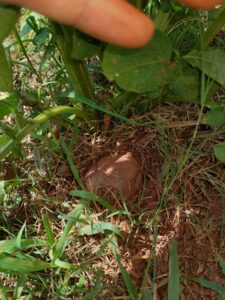
However, strictly keep trees, roots, and water-sucking vegetables like apples, Cherry, Turnips, and Cucumbers away to prevent growth inhibition.
Read more to find out why some plants are great companions to Potatoes and how to grow them more effectively.
Table of Contents Show
Why does Potato Need Companion Plants?
Although Potatoes do not look pleasing as flowering plants, Potatoes often make the most grown garden plants.
The starchy tuber plant, also known as Solanum tuberosum, grows well in cool and warm temperatures and USDA zones 3 to 10b.
It takes the least effort to grow such delicious yields and helps keep the garden weed-free, making it an instant favorite.

Remember, Potatoes need full sun, loose and fertile soil, with 1 to 2 inches of weekly watering.
Moreover, most tuber varieties are ready to harvest within 70-100 days. Therefore, many gardeners love growing Potatoes in their garden and use the harvest for culinary purposes.
A single crop can grow up to 40 inches (100 cm), and the tubers will spread about 10-18 inches in the soil, requiring a larger field.
In the latter growing stage, it may take up a lot of nutrients from the soil, affecting the growth of surrounding plants.
In fact, it will constantly attract pests like wireworms, tubeworms, white grubs, and weevils, which significantly damage the yields.
One effective way to deter these pests is to grow companion plants that will help prevent these pests and provide many other benefits.
| Benefits | Specification |
|---|---|
| Repel insects | Companion plants are quite effective in repeling cabbage worms, cucumber beetles, flea beetles, and moths that will plague young potato saps. |
| Attract pollinators | Growing flowering plants beside potato bed will attract great pollinators like bees and ladybugs. |
| Improve soil nutrients | Potato takes up a lot of nutrients in the latter stage. companions like bush beans put back nitrogen into the soil, replenishing the nutrients. |
| Provide ground cover | Ground covering plants like blanket flower or oregano will protect the potato bed from extreme heat and drought. |
If you are worried about other garden plants ruining your Potato yields, consider growing them in containers, raised beds, or produce bags.
Read about growing Potatoes in Texas with USDA Zones 6 to 9b and temperatures ranging from 0 °F to 30 °F .
Best Potato Companion Plants
Before growing plants around the Potato bed, consider looking closely at their needs.
Generally, Potatoes benefit from companion plants with identical or similar requirements, such as plants that do well in full sun with loose or moist soil and a slightly acidic texture.
In addition, you can fertilize them every 3 to 4 weeks, or at the same time, you would fertilize the Potato field.
Here is the list of companion plants appropriate for Potatoes.
Vegetable Companion Plants
Growing vegetables along the Potato beds is the best idea as it helps repel many harmful pests from the tubers.
Here are a few recommendations.
1. Legumes
Legumes make a great choice to grow along Potato plants as they release much-needed nitrogen into the soil.
Moreover, legumes such as peas and beans help improve the soil condition, allowing Potato tubers to expand further.
On the other hand, Potato helps deter the Mexican bean beetle that commonly infests legumes.

Legumes may include chickpeas, black beans, green beans, etc., which grow best in slightly acidic and loamy soil, ideal for Potatoes.
However, keep a few feet of distance in between to ensure undeterred tuber growth when planting beans with Potatoes.
2. Horseradish
Horseradish is a commonly grown culinary vegetable that makes a perfect Potato companion.
The pungent fleshy root of horseradish repels Colorado Potato beetles, a common Potato pest, and also improves Potatoes’ disease resistance.
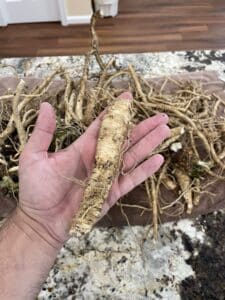
Horseradish prefers deep, moist loamy soil and a sunny location appropriate for Potatoes. Ensure the soil is loamy and water regularly to ensure the roots are not malformed.
In addition, keep a 2 to 3 feet distance between the two plants to avoid the tubers fighting for the same nutrients.
In an ideal conditions, it may take up to one year to reach maturity for harvest.
3. Corn
Corn and Potato companion plants work great. Corn is unlike Potatoes and requires very little soil as it grows above-ground
Therefore, growing corn will be less likely to compete with Potatoes for soil nutrients.
Consider sowing them 1 to 2 inches deep before spring and using at least three seeds to boost the germination rate when growing corn.
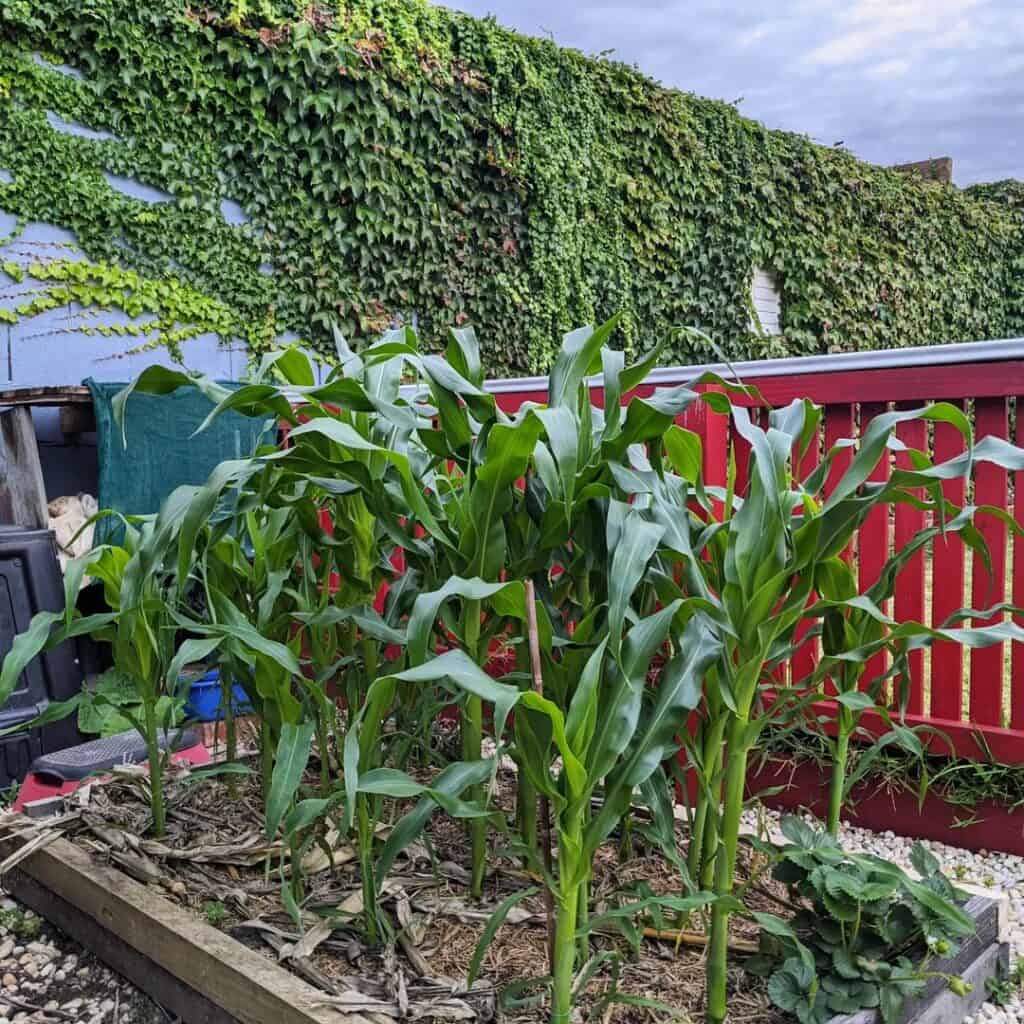
It prefers loamy and fertile soil with a neutral pH level of 6.0-6.8. Some even prefer heavy clay soil.
Therefore, growing them a few feet apart from Potatoes may be best to ensure individual growth.
4. Cabbage Family Plants
The cabbage family makes an excellent choice for many house gardens because they take up less space and grow without much effort.
The plants like broccoli, cauliflower, cabbage, and kale boast shallow root systems which would not interfere with Potato tubers.

In fact, both plants will thrive along with each other as they will not compete for space and nutrients.
When considering growing cabbage, choose red and purple varieties that reduce cabbage worm damage.
Keep at least 18 to 24 inches apart, ensuring Potatoes do not suck up nutrients for the cabbage plants.
Herb Companion Plants
Herbs make great garden companions for many plants as they help keep pests away, improve soil condition, and are less likely to interfere with soil nutrition.
They make plentiful harvests for culinary and medicinal purposes and can be picked at any time of the year.
Here are a few herb companion recommendations for Potatoes.
1. Basil
Basil is a sweet-smelling aromatic herb that keeps blooming throughout the year and thrives in a warm environment with loamy, fertile soil.
In fact, it will be a great Potato companion as it helps suppresses pest infestation with its aromatic scent.

The purplish-white flowers also attract pollinators like bees and ladybugs.
In addition, the tall-growing herb will provide much-needed shade and cool temperature to Potatoes.
In some cases, basil improves the essential oil content of the companion plant and even enhances its taste.
Read more to learn about Basil companion plants.
2. Tansy
Tansy is a lesser-known herb with bright yellow flowers that attract beneficial pollinators to the garden.
The herbaceous flowering plant is naturally found in meadows, roadsides, and ditches because it is known to be an invasive plant.
You can grow them around the Potato and vegetable fields to keep the pests away, where they will grow 3 to 4 feet tall.

However, ensure it does not get inside the landscape to keep it from reproducing rapidly.
You can introduce a mesh around the plant to keep it from falling onto the other side of the landscape.
3. Cilantro
Cilantro, also known as coriander, is a favorite companion plant for veggies like Potatoes.
A popular kitchen herb spreads an aromatic scent that keeps away many harmful pests, such as the Colorado Potato.
It also boasts umbrella-shaped flowers that will attract many beneficial insects like ladybugs, hoverflies, and lacewings.
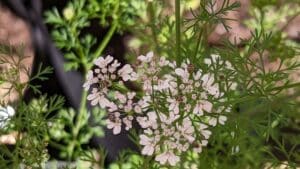
Cilantro thrives in well-draining soil with slight acidity ranging between 6.2 to 6.8 pH.
Remember, it needs full sun around the year and regular pruning to keep it growing.
Flowering Companion Plants
Flowers are favorite garden plants that attract pollinators and deter harmful pests that may otherwise infest small plants.
The flower scent will help keep many harmful pests away from the Potatoes.
1. Marigold
Marigolds are flowering plants that thrive in most home gardens.
It also makes a perfect Potato companion by inviting beneficial bugs like bees, parasitic wasps, hoverflies, and ladybugs.
In fact, it is known to be very effective in repelling soil-borne pests’ like Potato beetles.
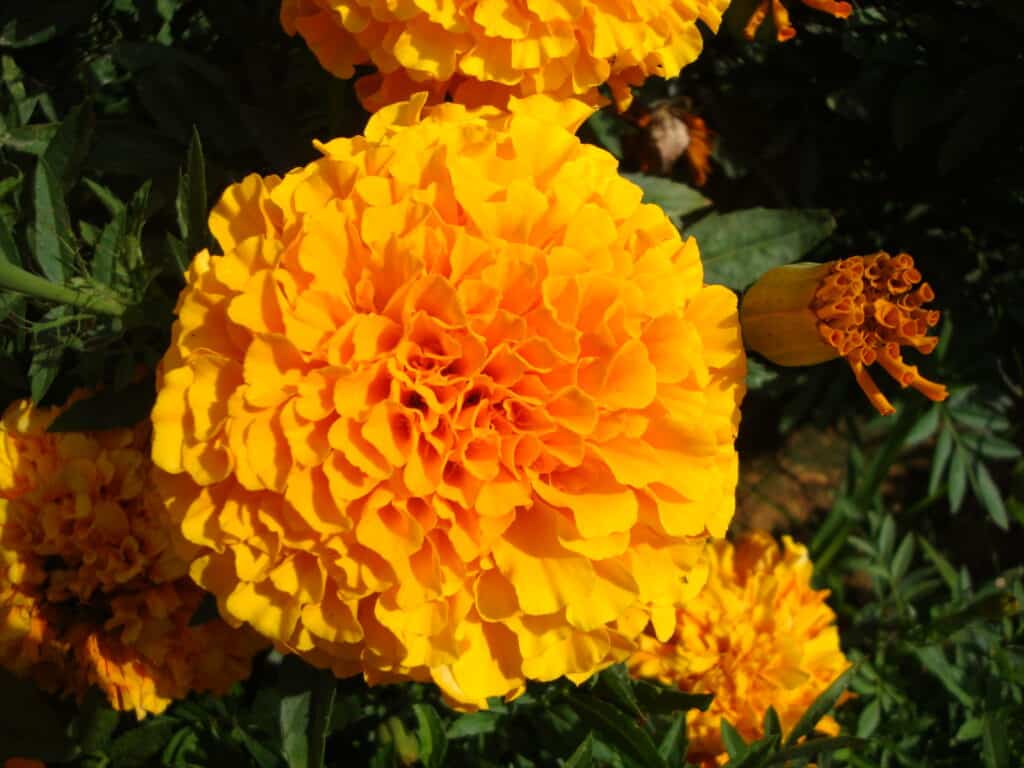
Moreover, it thrives in full sun and hot summer, providing much-needed shade to the Potato fields.
When growing close to Potato fields, choose French marigolds that survive wet conditions.
Otherwise, you can grow drought-tolerant African and signet marigolds bordering the Potato fields.
Ensure to plant them at least 2 feet apart to prevent overcrowding.
Read more about Marigold companion plants.
2. Alyssum
Alyssum is the blanket flower or ground-covering plant that helps keep the soil cool.
Potatoes will significantly benefit from the Alyssum plant as it provides much-needed shade and deters weeds.
Growing Alyssum close to the Potato garden will also help serve as a natural mulch and improve soil nutrients.
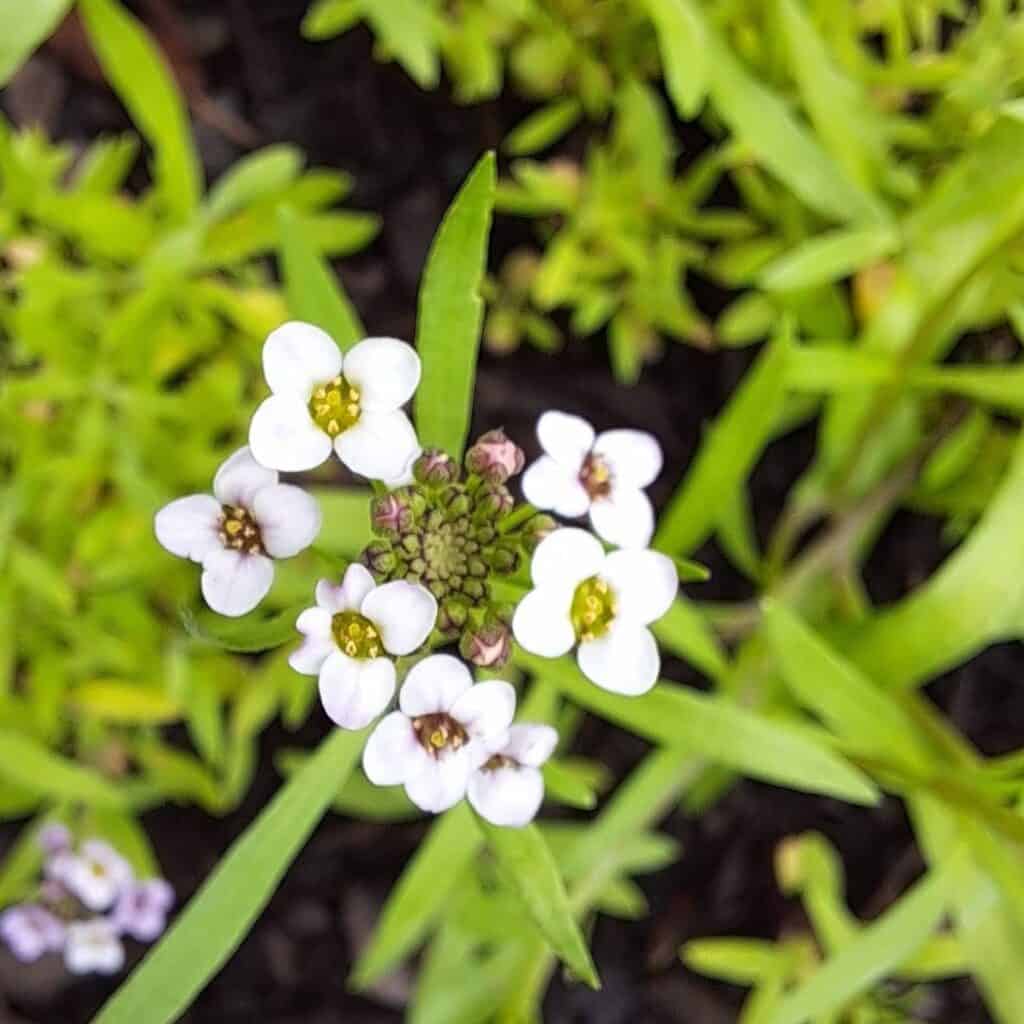
It requires well-drained, humus-filled soil that retains a lot of moisture. Care to plant them in early spring to witness lush white flowers within 9 to 10 weeks.
3. Nasturtiums
Nasturtiums are cheerful, easy-to-grow flowers with bold, colorful blossoms and edible foliage.
They are very attractive and versatile, often grown as landscape flowers. Moreover, the plant is known to lure aphids and squad bugs away from nearby plants.
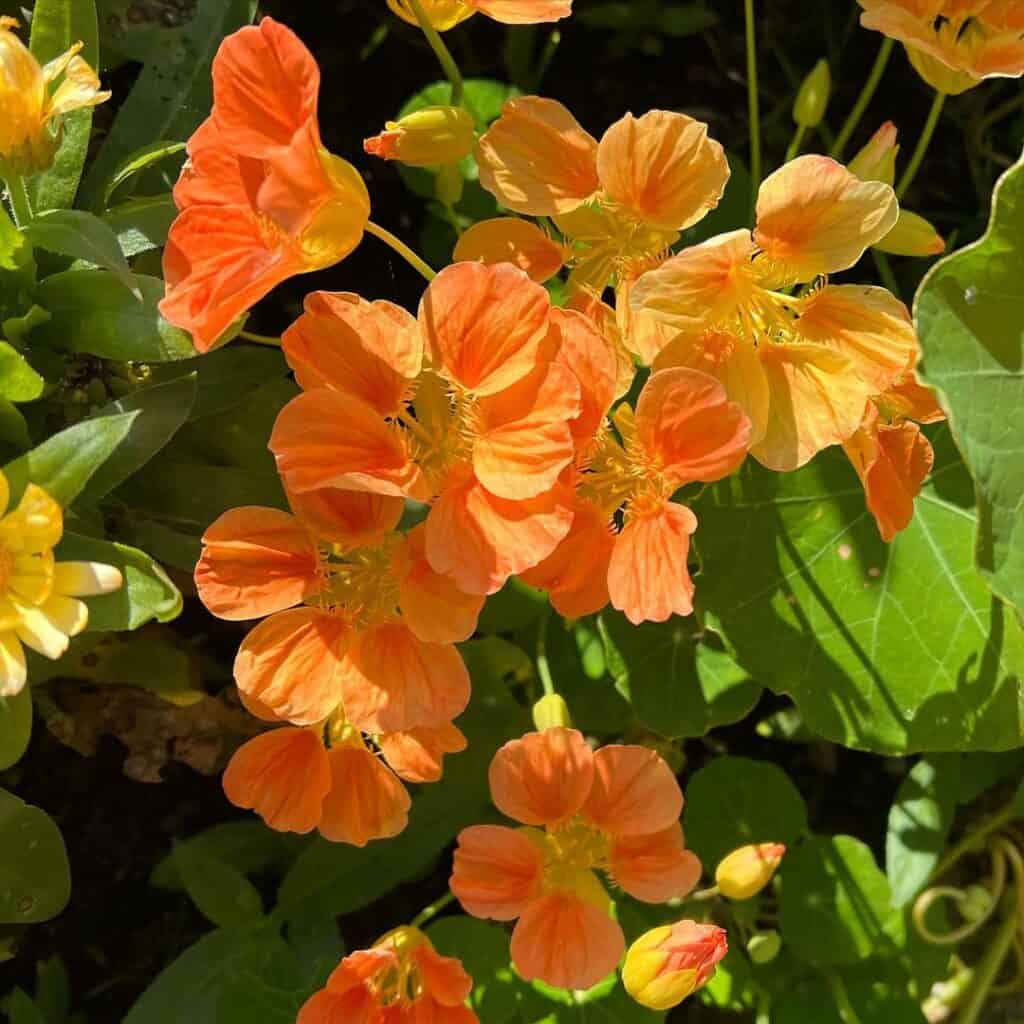
Therefore, it will help prevent aphid infestation in your Potato garden. They will also attract pollinators like hoverflies in the garden, benefiting other flowering plants.
Choose to grow them along the garden borders to deter pests and inhibit their growth a few feet away from Potato beds.
What Not to Grow With Potatoes?
Not all plants make ideal Potato companions, especially those that feed on many nutrients and take up enough space.
In fact, growing your Potatoes close to these plants will inhibit their growth by taking away nutrients and introducing many harmful pests.
Here are a few examples.
| Plants | Reason |
|---|---|
| Fruit Trees | Fruits like apple, peach, and cherry inhibit potato growth by taking away all the nutrients. They often introduce blight disease. |
| Cucumbers | Cucumbers love moist soil as it takes up a lot of water and nutrients that are equally required by potatoes. |
| Eggplants | Eggplants demand a lot of soil nutrients and are susceptible to soil-borne diseases which may affect potatoes. |
| Pumpkins | Pumpkins are susceptible to blight disease which often affect close-grown plants. |
| Raspberries | Raspberries take up enough soil nutrients and are susceptiple to diseases such as blight. |
| Fennel | Fennel does not grow well with other vegetables and may even stunt potato growth. |
| Tomatoes | Tomatoes are nightshade plants that crave for same soil nutrients and introduce many soil-borne diseases. |
Proven Tips for Companion Planting of Potatoes
Choose plants that enjoy similar soil conditions, temperature, fertilizing needs, and watering, when growing Potato companion plants.
- Always keep 3 to 4 feet of distance between Potatoes and other root plants to prevent inhibited root growth.
- To ensure good yields, plant the seedlings 6 to 8 inches deep into the soil.
- Always use organic fertilizer with rich phosphate and potash content for Potatoes. Companion plants will provide the remaining nitrogen content.
- Water companion plants every 7 to 10 days and provide 1 to 2 inches of water.
- Choose raised garden beds to grow Potatoes if the companion plants require neutral or more alkaline soil.

Conclusion
Use suitable companion plants to grace your Potato field with healthy and good harvests.
Use this guide to determine what other plants make great companions to Potatoes.
However, do not forget to harvest your produces on time to avoid different soil-borne pests from damaging them.
Usually, Potatoes are ready to harvest in 10 weeks or 2.5 months.
Related Article: Can you eat Potato leaves?


